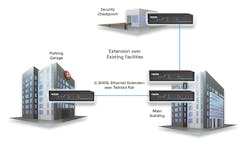Using existing twisted-pair cabling A common application is a security checkpoint services upgrade. The checkpoint may have originally been connected only with twisted-pair cable to support an analog phone. By using a pair of Ethernet extenders (near-end/far-end), the checkpoint can be upgraded to support an Ethernet LAN connection, a VoIP phone, and an IP camera.
Using existing coax cabling Another common application is a security camera network upgrade. When you replace older, analog security camera systems with newer, digital IP cameras, you can save a lot of installation time (and labor costs) by using the existing coax cabling with Ethernet extender on each end.
3. Wireless Ethernet extension2.4-/5-GHz radio extension Wireless Ethernet extenders provide a very cost-effective method for extending a LAN/WAN beyond 100 meters. They eliminate the need to buy new cable, dig expensive trenches for fiber cable, and also the time-consuming waits for rights of way. Wireless Ethernet extenders are the most seamless way to extend LAN connections up to several miles across office parks; on business, educational, and medical campuses; in enterprise business complexes; and in industrial settings, such as factories or oil/gas field drilling operations, and even in traffic control. Wireless Ethernet is frequently used to connect line-of-sight networks that are miles apart. While wireless extension is often used in enterprise business applications, where it really shines is in industrial applications, such as data acquisition, control, and monitoring; HVAC controls; and security and surveillance, to name a few. The extender radios can also be PoE powered to simplify installation.
Cellular extension Cellular wireless routers provide an alternative to wireless Ethernet extension. Anywhere you can get cellular phone reception, you can set up a network. Cellular routers can be used to provide the primary network connection for industrial environments where it’s too expensive or impractical to run a wired access network, such as cable or DSL. Cellular routers are also used in factories, oil/gas field drilling operations, and in traffic control. Cellular routers are available for all the major carriers (AT&T, Sprint, and Verizon) and all networks (3G, 4G, and LTE). Cellular routers eliminate any line-of-sight and distance limitations that may exist with radio wireless extension.
KEITH ROSS is Global Networking Product Manager at Black Box. This article was originally published at the Black Box Technology Blog. 

